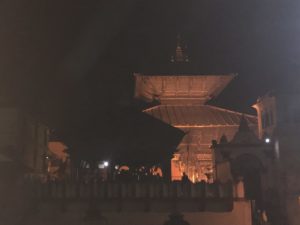
By Isabella Kazanecki, 08/09/2017. The Bagmati River feeds into the Ganga. I learned this after stalking all I could find about my mysterious neighbor. The Bagmati runs through the area in which we have been living and our friends noticed that I am curious about it so they took me to Pashupatinath temple which lies on the banks of this holy river. This temple is a UNESCO World Heritage site as well as the most revered temple in Kathmandu. Most people we’ve spoken to call it the holiest temple in Nepal. The pooja that we witnessed was similar to those in Varanasi besides the fact that this one seemed more festive. People were clapping and singing, these two women had climbed up onto a ledge and started dancing along to the music, and we watched gleefully from the bridges that connected the temples on both sides of the Bagmati.
Though in the space directly beside the pooja was the area for cremations. I watched as a deceased person’s toes were dipped into the river and a friend informed me that this was a tradition in which the family makes sure their beloved relative is dead before being carried to cremation. It is a last hope that they will revive.
Much like the Ganga, the Bagmati is extremely polluted. Nepali people also call it the dirtiest river in Nepal. In fact, the other day I was in the car with a man from Kathmandu and as we drove by, he rolled down the window, pointed, and said “Look, Isabella. This is the dirtiest river in Nepal. It is called Bagmati, though it is very holy.” Ama even told us that she used to wash clothes in the river years ago but this is not possible now due to the toxicity.
So I thought I had lost the Ganga by coming here but in fact I followed her to her roots. I’ve experienced a deep connection with this river here and the power that a body of water can have and the life that it can create never ceases to amaze me.
